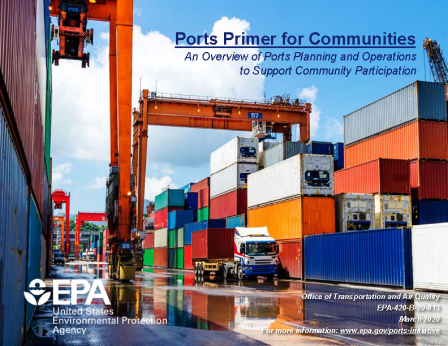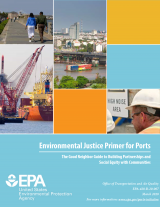Environmental Justice Primer for Ports
The Good Neighbor Guide to Building Partnerships and Social Equity with Communities
- Welcome!
- Formats - Environmental Justice Primer for Ports
- Background
- How to Use this Document
- Acknowledgements & References
Welcome!
The Environmental Protection Agency’s (EPA’s) Office of Transportation and Air Quality (OTAQ) has developed this guidance, the Environmental Justice Primer for Ports: The Good Neighbor Guide to Building Partnerships and Social Equity with Communities (The Environmental Justice Primer for Ports). It is intended to help port decision-makers better understand the needs of near-port communities, how they can help address these needs, and build productive community relationships during planning activities and operations.
The Environmental Justice Primer for Ports features case studies that reflect a range of port experiences, including ports with extensive community engagement experience and those just starting to interact with nearby communities. Section A provides port decision-makers with an overview of environmental justice principles and how they apply within the context of port operations and decision-making. Section B provides a step-by-step guide to enhance community engagement, build and strengthen relationships, and improve quality-of-life outcomes for near-port communities.
 Figure 2: Community Action Roadmap
Figure 2: Community Action Roadmap Figure 1: Ports Primer for Communities
Figure 1: Ports Primer for Communities
Formats - Environmental Justice Primer for Ports
The Environmental Justice Primer for Ports is available as a PDF document that can be downloaded (see link below), and viewed on these webpages in HTML format by selecting the icons in the navigation bar at the top of each page to navigate between sections (from Step 2 to Step 3, for example). Additionally, the links at the bottom of each page can be used to move between sub-sections (such as advancing from Step 2 to Step 3). We've made identical Environmental Justice Primer for Ports content available in both formats to maximize accessibility to as many stakeholders as possible. The PDF document is portable with the ability to access content offline and the webpages are available online. Both formats can be printed. There are some slight differences with how information is organized in the webpages, but the content is not altered. Links throughout the Environmental Justice Primer for Portsin both formats allow users to access additional online resources.
Environmental Justice Primer for Ports (PDF) (48 pp, 936 K, March 2020, EPA-420-B-20-007, About PDF)
Background
The business case for proactive engagement with near-port communities is compelling. Global climate change, natural resource depletion and international competitiveness are shifting business models to a triple-bottom-line approach that includes social, economic and environmental performance measures. Consideration of social and environmental impacts has become a defining characteristic of forward-thinking businesses and governments. These leaders benefit from increased community and stakeholder trust as well as resource efficiency and innovation.1 These approaches also help businesses and governments meet regulatory requirements and avoid risks and losses from lack of community support, negative press and litigation.
Ports play an important role in sustaining local, regional and national economies. Port operations and associated travel and freight transport activities also impact near-port communities. They can cause cumulative environmental challenges such as air, water and land pollution, as well as land use conflicts that impact local quality of life. As port decision-makers consider how to address community impacts, they are balancing a range of new industry challenges, including climate adaptation, post-Panamax shipping infrastructure needs, and workforce development.
The Environmental Justice Primer for Ports provides tools and resources for ports agencies to proactively engage community stakeholders in addressing these pressing challenges to ensure shared prosperity and regional resilience.
How to Use this Document
This document offers guidance for ports seeking to build partnerships and social equity with near-ports communities. Section A provides a primer on environmental justice and effective community engagement.
Section B provides a roadmap for six key steps to build partnerships and social equity. The Overview provides an outline of the roadmap and a diagram of the steps. Each step is described in more detail on the remaining pages, along with sample exercises.
The Appendix offers a timeline of the environmental justice movement as well as additional resources to assist with implementation.
Additional Educational Resources
As a result of the pilot projects, new tools have been developed that are part of the Port and Near-Port Community Capacity-Building Toolkit being hosted on EPA’s Office of Transportation and Air Quality website. Click here to explore the new tools!

